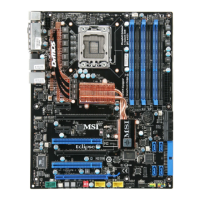
Do you have a question about the MSI MS-7520 ECLIPSE Series and is the answer not in the manual?
| Model | MS-7520 |
|---|---|
| Series | ECLIPSE Series |
| Form Factor | ATX |
| Chipset | Intel X58 |
| CPU Socket | LGA 1366 |
| Memory Type | DDR3 |
| Memory Slots | 6 |
| Max Memory | 24 GB |
| PCI Express x16 | 3 |
| SATA Ports | 6 x SATA 3Gb/s |
| USB Ports | 12 x USB 2.0 |
| LAN | Dual Gigabit LAN |
| Memory Standard | DDR3 800/1066/1333 |
| RAID Support | RAID 0, RAID 1, RAID 5, RAID 10 |
| Audio | Realtek ALC889 8-channel HD Audio |
| Power Connector | 24-pin ATX |
Details the technical specifications of the MS-7520 mainboard, including processor, chipset, memory, and connectivity.
Provides a visual guide to the MS-7520 mainboard, identifying key components and connectors.
Lists all items included in the retail package of the MS-7520 mainboard for user verification.
An overview of the mainboard components and their locations, with references to detailed sections.
Step-by-step instructions for installing the Central Processing Unit (CPU) and its cooler.
Guidelines for installing DDR3 memory modules into the DIMM slots for optimal performance.
Details on connecting the ATX 24-pin and 12V power supply connectors to the mainboard.
Description of the ports and connectors available on the mainboard's back panel.
Information on connecting front panel switches, LEDs, and serial port headers.
Explanation of the function of onboard buttons like Power and Reset.
Details on the PCI Express and PCI slots, including their specifications and capabilities.
Instructions for using onboard switches, specifically the CPU base clock overclocking switch.
Identifies and explains the function of various LEDs on the mainboard.
Instructions on how to access the BIOS setup utility during system startup.
Guide to navigating the BIOS setup menus, control keys, and obtaining help.
Configuration options for basic system settings like date, time, and storage devices.
Settings for performance enhancements, boot options, and system security.
Configuration for onboard devices such as USB, LAN, and IEEE1394 controllers.
Options for configuring ACPI states and system power saving modes.
Displays real-time hardware status, including voltages, temperatures, and fan speeds.
Controls for the Green Power feature, managing power phase and LEDs for energy saving.
Procedure for setting or clearing a BIOS password to protect system configuration.
Advanced settings for CPU frequency, voltage, and overclocking.
Allows saving and loading custom BIOS configurations for easy restoration.
Procedure for updating or loading the BIOS from a USB or storage drive.
Options to restore BIOS settings to factory defaults (Fail-Safe or Optimized).
Overview of the X-Fi Xtreme Audio Card and its advanced audio functions.
Details the audio quality, technologies, and standards supported by the X-Fi card.
Step-by-step guide on how to physically install the X-Fi Xtreme Audio Card into the PCI-E slot.
Instructions for installing the Creative audio driver for Windows XP/Vista.
Guide to configuring the audio features and applications after driver installation.
Instructions on how to launch the Overclocking Center utility from the desktop or start menu.
Displays detailed information about the mainboard, memory, PCI devices, and CPU.
Configuration options for Dynamic Overclocking Technology (DOT) in Basic and Advance modes.
Overview of Intel ICH10R SATA RAID capabilities and features.
Steps to enable Intel Matrix Storage Manager Option ROM in BIOS for RAID setup.
Procedure for creating RAID volumes using the Intel RAID Configuration Utility.
Instructions on how to delete existing RAID volumes, noting data loss.
Process to remove RAID structures and revert drives to non-RAID mode.
Configuration for recovery volume creation and update policies.
Guide for installing Intel RAID drivers during operating system setup.
Instructions for installing the Intel Matrix Storage Console software.
Steps for upgrading a single SATA drive to a RAID configuration.
Procedures for handling degraded RAID arrays due to drive failure or disconnection.
Overview of JMicron JMB362 RAID capabilities supporting RAID 0, 1, and JBOD.
Guide to using the JMicron RAID BIOS utility for configuring RAID arrays.
Step-by-step process for creating RAID 0, 1, or JBOD arrays using the utility.
Instructions on how to delete existing JMicron RAID sets.
Procedure to remove RAID structures and revert drives to non-RAID state.
Steps to resolve mirror conflicts in RAID 1 arrays by setting the source drive.
Guide on how to rebuild RAID 1 arrays after a drive failure or disconnection.
Using the JMRaidTool application for viewing and managing JMicron RAID arrays.
Details on creating RAID 0, 1, and JBOD using the JMRaidTool.
Overview of the Drive Booster Manager for configuring RAID functionality.
Step-by-step guide for installing the Drive Booster Manager software.
Instructions on launching the Drive Booster Manager utility.
How to view information about SATA drives and controllers using the utility.
Procedure for setting a password for a specific RAID volume within the manager.
Instructions for deleting RAID modes from SATA drives using the manager.
Accessing and viewing the log of significant events within the Drive Booster Manager.